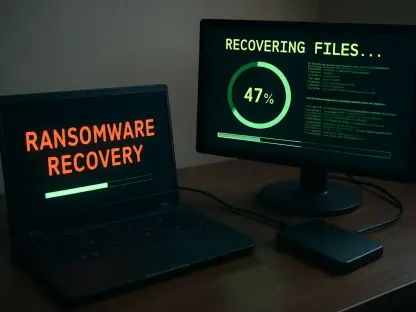In the sprawling ecosystem of software development, a staggering number of developers rely on npm, the largest package manager for JavaScript, to build and deploy their applications, but beneath this veneer of convenience lurks a growing danger: malicious packages designed to exploit trust and infiltrate supply chains. A recent campaign orchestrated by a threat actor known as “dino_reborn” has unveiled a chilling reality, with deceptive npm packages redirecting users to cryptocurrency scams through an innovative misuse of Adspect cloaking technology. This review delves into the intricacies of this sophisticated attack vector, examining its mechanisms, impact, and the broader implications for open-source security in 2025.
Understanding the Threat Landscape of Npm
Npm stands as a cornerstone for JavaScript developers, hosting millions of packages that streamline coding processes. However, its open nature makes it a prime target for cybercriminals seeking to distribute malware under the guise of legitimate code. The emergence of malicious packages as a supply chain attack vector underscores a critical vulnerability: the implicit trust developers place in these repositories often bypasses rigorous scrutiny.
This specific campaign, involving seven harmful packages, highlights how attackers exploit this trust to embed malicious scripts. Once integrated into a project, these scripts execute automatically, often without immediate detection. The scale of reliance on npm amplifies the potential damage, as a single compromised package can affect countless downstream applications and users.
The broader cybersecurity landscape reveals that such threats are not isolated incidents but part of a rising trend targeting open-source platforms. As software supply chains become more interconnected, the ripple effects of a breach extend far beyond individual developers, posing systemic risks to entire industries. This review aims to unpack the technical and strategic elements of this particular threat to inform better defenses.
Dissecting the Malware Campaign’s Core Features
Distribution Tactics on Npm
The threat actor behind this campaign, identified as “dino_reborn,” uploaded seven malicious packages to the npm repository, capitalizing on the platform’s accessibility. These packages were crafted to blend seamlessly with legitimate offerings, exploiting the inherent trust developers have in community-shared code. Their integration into projects often goes unnoticed until significant harm is done.
A key feature of these packages is their use of Immediately Invoked Function Expressions (IIFE), which enable automatic execution of malicious code upon installation. This technique ensures that the malware activates without requiring explicit user interaction, making it particularly insidious. Developers, often focused on functionality rather than security, may inadvertently propagate the threat through their software.
The rapid dissemination potential within npm’s ecosystem means that even a short window of availability for these packages can result in widespread compromise. While the offending packages were eventually removed, their initial presence underscores the challenge of preemptively identifying malicious content in a repository of such vast scale.
Innovative Use of Adspect Cloaking
One of the standout aspects of this campaign is the deployment of Adspect, a cloaking service originally intended for ad campaign protection. Repurposed for malice, Adspect enables the malware to distinguish between potential victims and security researchers by analyzing user data such as IP addresses and browser behavior. This differentiation allows the attack to tailor its response accordingly.
For unsuspecting users flagged as targets, the malware presents a deceptive path leading to cryptocurrency scams. Meanwhile, researchers are redirected to benign or decoy content, effectively masking the true nature of the threat. This rare application of cloaking in supply chain attacks marks a significant evolution in evasion tactics, complicating detection efforts.
The use of Adspect demonstrates a level of sophistication uncommon in npm-based threats, as it borrows techniques more typically associated with malvertising or affiliate fraud. This cross-pollination of attack methodologies signals a worrying trend where cybercriminals adapt tools from disparate domains to enhance their effectiveness in software ecosystems.
Psychological Manipulation through Fake CAPTCHAs
Beyond technical innovation, the campaign employs psychological tactics to deepen its impact, notably through the use of fake CAPTCHAs. These mimics of familiar security prompts delay redirects to scam sites, a move designed to bypass automated security tools that flag immediate redirections as suspicious. The delay creates a window of opportunity for the attack to proceed undetected.
Equally important is the effect on user behavior, as CAPTCHAs are often associated with trusted platforms. By presenting this familiar interface, the malware builds a false sense of security, encouraging users to proceed without suspicion. This manipulation of trust is a powerful tool, lowering psychological barriers to engagement with malicious content.
Such tactics reveal a calculated blend of technology and human psychology, exploiting cognitive biases to maximize the attack’s success rate. The dual purpose of evading technical defenses while influencing user decisions underscores the multifaceted nature of modern cyber threats, demanding a response that addresses both dimensions.
Performance and Real-World Impact
The ultimate goal of this malware campaign is to redirect users to fraudulent cryptocurrency websites masquerading as legitimate exchanges like standx.com and uniswap.org. Once lured to these sites, victims face significant financial risks, often losing funds through deceptive transactions or data theft. The personal toll on affected individuals can be devastating, eroding trust in digital finance platforms.
Beyond individual losses, the campaign’s impact reverberates through the software development community, casting doubt on the reliability of open-source resources. Developers who unknowingly incorporate compromised packages risk damaging their own reputations and the integrity of their projects. This cascading effect highlights the systemic vulnerabilities inherent in interconnected supply chains.
A notable deflection tactic targets security researchers, redirecting them to a polished decoy page for a fictitious entity called Offlido. Complete with legal disclaimers, this page is designed to waste time and obscure the campaign’s true intent. Such measures illustrate the lengths to which threat actors go to protect their operations from scrutiny, further complicating mitigation efforts.
Challenges in Countering Sophisticated Threats
Detecting malware that employs cloaking technology like Adspect presents formidable technical challenges. Its ability to differentiate between victims and analysts means that traditional security tools, reliant on static signatures or predictable behavior, often fail to identify the threat. This dynamic adaptability requires a shift toward more heuristic and behavioral analysis in defense strategies.
Securing open-source repositories against such sophisticated supply chain attacks remains a daunting task. The sheer volume of contributions to platforms like npm makes manual vetting impractical, while automated systems struggle to keep pace with evolving attack methods. Balancing accessibility with security is a persistent dilemma for repository maintainers.
Efforts by cybersecurity teams and npm administrators to remove malicious packages and bolster platform defenses are ongoing, yet gaps persist. Continuous monitoring for unusual scripts or unexpected data transmissions is essential, as is fostering a culture of vigilance among developers. However, the cat-and-mouse game with threat actors suggests that reactive measures alone are insufficient for long-term protection.
Evolving Trends and Future Security Outlook
Supply chain attacks targeting open-source platforms are growing in both frequency and complexity, reflecting a broader shift in cybercrime strategies. The integration of advanced technologies like cloaking services with psychological manipulation tactics points to a future where attacks are increasingly difficult to predict or prevent. Staying ahead of these trends demands innovation in detection methodologies.
Looking ahead from 2025 to 2027, the likelihood of similar campaigns reappearing with novel cloaking mechanisms or proxy infrastructures remains high. Threat actors are adept at iterating on successful tactics, potentially incorporating machine learning or other emerging technologies to further obscure their activities. Proactive investment in adaptive security frameworks will be crucial to counter these developments.
The long-term impact on trust within open-source ecosystems cannot be understated, as repeated incidents may deter developers from relying on shared resources. Building resilience will require not only technical solutions but also community-driven initiatives to promote transparency and accountability. The stakes for software development and digital security are immense, necessitating a collective response to safeguard this vital domain.
Final Reflections and Path Forward
Reflecting on this campaign, the ingenuity of the “dino_reborn” operation was evident in its seamless integration of Adspect cloaking and psychological ploys to execute cryptocurrency scams. The ability to evade detection through tailored responses to different users marked a troubling advancement in supply chain attacks. Its impact on victims and the broader npm ecosystem served as a stark reminder of the vulnerabilities embedded in open-source platforms.
Moving forward, actionable steps emerged as critical necessities, such as enhancing real-time monitoring for suspicious scripts and educating developers on the risks of unverified packages. Collaboration between repository maintainers and cybersecurity experts became imperative to develop robust vetting processes. Exploring automated anomaly detection powered by artificial intelligence offered a promising avenue to preempt future threats.
Ultimately, the journey toward securing software supply chains demanded a multilayered approach, blending technology with awareness. Strengthening community standards for code submission and fostering a proactive security mindset among stakeholders stood out as essential strategies. These efforts aimed to rebuild confidence in open-source resources, ensuring that innovation could thrive without the shadow of exploitation.









